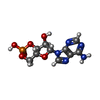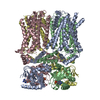+検索条件
-Structure paper
| タイトル | Cryo-EM structure of human HCN3 channel and its regulation by cAMP. |
|---|---|
| ジャーナル・号・ページ | J Biol Chem, Vol. 300, Issue 6, Page 107288, Year 2024 |
| 掲載日 | 2024年4月16日 |
 著者 著者 | Bo Yu / Qiuyuan Lu / Jian Li / Xinyu Cheng / Han Hu / Yuanshuo Li / Tong Che / Yaoguang Hua / Haihai Jiang / Yuting Zhang / Cuiling Xian / Tingting Yang / Ying Fu / Yixiang Chen / Weiwei Nan / Peter J McCormick / Bing Xiong / Jingjing Duan / Bo Zeng / Yanyan Li / Yang Fu / Jin Zhang /   |
| PubMed 要旨 | HCN channels are important for regulating heart rhythm and nerve activity and have been studied as potential drug targets for treating depression, arrhythmia, nerve pain, and epilepsy. Despite ...HCN channels are important for regulating heart rhythm and nerve activity and have been studied as potential drug targets for treating depression, arrhythmia, nerve pain, and epilepsy. Despite possessing unique pharmacological properties, HCN channels share common characteristics in that they are activated by hyperpolarization and modulated by cAMP and other membrane lipids. However, the mechanisms of how these ligands bind and modulate HCN channels are unclear. In this study, we solved structures of full-length human HCN3 using cryo-EM and captured two different states, including a state without any ligand bound and a state with cAMP bound. Our structures reveal the novel binding sites for cholesteryl hemisuccinate in apo state and show how cholesteryl hemisuccinate and cAMP binding cause conformational changes in different states. These findings explain how these small modulators are sensed in mammals at the molecular level. The results of our study could help to design more potent and specific compounds to influence HCN channel activity and offer new therapeutic possibilities for diseases that lack effective treatment. |
 リンク リンク |  J Biol Chem / J Biol Chem /  PubMed:38636662 / PubMed:38636662 /  PubMed Central PubMed Central |
| 手法 | EM (単粒子) |
| 解像度 | 2.72 - 3.19 Å |
| 構造データ | EMDB-35602, PDB-8inz: EMDB-35603, PDB-8io0: |
| 化合物 | 
ChemComp-VX9:  ChemComp-CMP: |
| 由来 |
|
 キーワード キーワード | MEMBRANE PROTEIN / human HCN3 channel |
 ムービー
ムービー コントローラー
コントローラー 構造ビューア
構造ビューア 万見文献について
万見文献について







 homo sapiens (ヒト)
homo sapiens (ヒト)